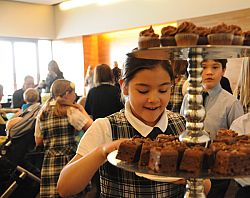Students get taste of history, with a sweet ending

SALT LAKE CITY — A trip to the Natural History Museum of Utah had a tasteful ending for J.E. Cosgriff Memorial School’s fourth-graders, who were on hand for the Feb. 7 unveiling of the "Chocolate: The Exhibition" at its Intermountain West premiere.
The exhibit features many aspects of the story of chocolate: its botanical facts, its use as not only a drink but as currency in the Aztec culture, and its journey from Mesoamerica across the ocean to Europe, where it was transformed into the candy familiar to the modern world.
"Now, why would a natural history museum have a chocolate exhibit?" asked Sarah George, executive director of the Natural History Museum of Utah, at the Feb. 7 press party. "The reason is that the story of chocolate throughout the years is very rich in both natural and cultural history, and there is an ancient story to tell about chocolate in Utah."
The presence of chocolate in Utah was first documented by Dorothy Washburn, an archaeologist at the University of Pennsylvania’s University Museum of Archaeology and Anthropology, and her husband, William Washburn, a chemist at Bristol-Myers Squibb. In 2013, they reported finding traces of theobromine and caffeine – chemicals found in chocolate – on 1,200-year-old bowls from an archeological site in Alkali Ridge, near Canyonlands National Park.
"It announced the earliest consumption of cacao in the United States," Dr. Glenna Nielsen-Grimm, anthropology collections manager at the Natural History Museum of Utah, told the Cosgriff students at the premiere.
Two of the pots that Washburn tested are on exhibit, courtesy of the Peabody Museum. Other pots from Alkali Ridge also are on display, from the Utah museum’s own collection.
After reading Washburn’s paper, experts at the Utah museum looked for traces of chocolate on pottery in their own collection, "and to our delight and surprise six of those shards came back positive. So what we have now is we have three sites in southeastern Utah dating to 750 CE that have tested positive for the use of cacao in this early time period," Nielsen-Grimm said as she explained how the chemical tests were conducted. The presence of chocolate in Utah in ancient times raises anthropological questions, because cacao trees aren’t native to the area, so scientists wonder "how it managed to get here," whether it was through trade or by people moving into the area, she said.
"Chocolate, the Exhibit" is from The Field Museum of Chicago, which first launched the traveling tour in 2002.
The redesigned exhibit now at the Natural History Museum of Utah "features compelling new hands-on interactives, sumptuous media, immersive imagery and objects that will take visitors beyond their sense of taste," said Amy Bornkamp, The Field Museum’s senior manager of exhibition planning and partnerships.
The exhibit is bilingual English/Spanish, because "given the history of chocolate production and consumption, it was very important that the exhibition, including this new version, was accessible to Spanish-speakers," she added.
Among the displays is one explaining the midge that pollinates the cacao flowers. This was the most interesting part of the exhibit for Cosgriff fourth-grader Maggie Simms. The tiny fly "can beat its wings 1,000 times in one second. I tried that. I had 10 seconds with 24 beats," she said.
Her classmate, Boden Chell, said his favorite part was learning information about the Aztec civilization, "how cacao beans were used to pay taxes and stuff."
"Chocolate: The Exhibition" runs through June 1 at the Natural History Museum of Utah, 301 Wakara Way in Salt Lake City. Public lectures and special chocolate tastings will occur throughout the exhibit. For information, visit http://www.nhmu.utah.edu/.
© Copyright 2024 The Diocese of Salt Lake City. All rights reserved.

Stay Connected With Us